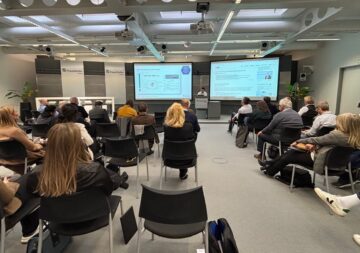
Industry 5.0 is a concept introduced by the European Commission in the early 2020s, representing a significant shift in our relationship with technology. This concept envisions technology as a companion designed to serve humanity meaningfully. As artificial intelligence and automation continue transforming the workplace and our daily lives, Industry 5.0 promotes a more human, sustainable, and responsible approach to technology – a shift toward a regenerative and human-centric industrial paradigm. This article will explore the key concepts of Industry 5.0 and technological humanism, their interconnection, and why Finland is positioned to lead this development.
Author: Harri Heikkilä
Technological evolution has advanced to a point where information technology is no longer limited to individual devices; instead, it is seamlessly integrated into the very fabric of our lives. We live in a digital world, even when not consciously interacting with devices. Communication, commerce, work, education, and healthcare are increasingly conducted through digital environments, blurring the lines between professional and personal life. There is no opt-out. This pervasive integration of digital technology forms what Floridi (2014) calls the ”infosphere,” a reality so intertwined with information technology that separating them has become nearly impossible. In today’s world extensive digital integration means that being left out of means a loss of participation and influence in society (Coeckelbergh 2020).
As technology increasingly integrates into our lives, we need more comprehensive design principles considering broader societal connections (Heikkilä 2023). This is also necessary because technology is inherently non-neutral; it actively influences individuals and society (Ede 2021). For instance, ubiquitous algorithms reflect the values of their creators (Bowles 2020), not to mention the data chosen for the training of AI. In this new digital landscape, people have begun transitioning being users to becoming targets. Prem (2024) warns that the extensive collection, analysis, and use of vast amounts of behavioural data to create prediction products and marketable services will establish a new power dynamic between those who observe and those who are observed. This imbalance of information will inevitably result in an unequal distribution of power. Zuboff (2019) even argues that ”surveillance capitalism” is no longer just a theoretical concern but an established economic reality. The initial optimism of the 1990s about the digital age has faded, replaced by concerns over misinformation, loss of privacy, and increased control.
Technological humanism – at the heart of Industry 5.0
This growing presence of technology in our lives inevitably raises fundamental questions about the relationship between technology and humanity. At the core of Industry 5.0 lies the concept of technological humanism – the application of Enlightenment principles in the digital age, where human dignity and common good guide the development and use of technology. Technological humanism represents a conscious effort to reclaim control from algorithmic dominance and to counter potential dystopian futures, such as Varoufakis’s (2024) notion of ”technofeudalism.” Grounded in the principles of the European Enlightenment, human rights, and the intrinsic value of civilisation, it posits that technology should serve the common good. This includes strengthening democracy, protecting privacy, ensuring freedom of expression, and promoting active participation.
To achieve this, transparency, fairness, and explainability in algorithms and data handling are essential to ensure that decisions affecting individuals and society remain firmly in human hands. The objective is not to halt technological advancement but to guide its trajectory consciously towards a more responsible, humane, and sustainable future. This requires collaboration across various disciplines, including technology, social sciences, business, environmental studies, and design. (Nida-Rümelin & Weidenfeld 2022.) Because every technological decision is a decision about the future we want to create (Bowles 2020).
It is important to understand that technological humanism does not aim to present technology as a cure-all or to pursue transhumanist ideals, nor does it incorporate any anthropocentric bias towards nature. Instead, it maintains an optimistic view of humanity’s capacity to ethically shape digital opportunities. It seeks to counter uncontrolled and deterministic development by placing trust in human reason while acknowledging the inherent limitations of digital technology. This perspective encourages an instrumental view: technology is a tool. Humans and machines are distinct but complementary partners rather than interchangeable entities. (Nida-Rümelin & Weidenfeld 2022.)
Furthermore, Enlightenment thinking translates into human-scaled design in the digital realm, promoting interfaces that respect and adapt to human capabilities, promoting inclusion, preventing information overload, and providing seamless, intuitive user experiences. This approach can be served by adopting ”calm technology,” which captures attention only, when necessary (Case 2015) and operates contextually and supportively in the background and promotes the idea of natural (NUI), or even “Zero interfaces” (Krishna 2015).
Although the term digital humanism is often used synonymously with technological humanism, the latter is not confined to the digital domain. For example, cities are technological entities only partially shaped by digital systems. Moreover, the term digital humanism can be misleading due to its proximity to digital humanities, which refers to an entirely different academic field.
Three pillars of technological humanism:
- Technology is not neutral; its profound impact on humans, society, and the environment necessitates an instrumental and responsible approach.
- The direction of technological development is a choice; it can and must be shaped in alignment with human values.
- Technology must serve the common good, enhancing participation, safeguarding rights, and supporting an ecologically responsible and sustainable future.
How to Respond to the Challenges of Industry 5.0?
In recent years, technological humanism has attracted international attention, particularly in Austria, Spain, and Italy. Barcelona has established itself as a ”city of human-centered technology,” making significant investments at the crossroads of technology, art, and science. Meanwhile, in Vienna, TU Wien has introduced a doctoral program dedicated to technological humanism. The European Union has also launched several Industry 5.0 initiatives, highlighting the importance of implementing more ethical digital strategies (European Commission 2025; Dixson-Declève et al. 2021).
Finland is well-positioned to take a leading role in applying Industry 5.0. Finnish society is generally positive toward technology, and Nordic design thinking — combining aesthetics of minimalism, usability, and responsibility — aligns well with the ethos of Industry 5.0. This shift presents strategic opportunities, particularly for applied sciences universities. There is a clear need to educate designers and decision-makers who also understand technology’s ethical, social, and cultural dimensions as well as the mechanisms of its diffusion and adoption. As Galobart (2022) states, we must combine technical and humanistic expertise. LAB University of Applied Sciences is in a strong position, as collaboration across design, technology, and business is already well established.
There is also a clear demand for this kind of education among students. Studies show that the new generation no longer views technology as an external, pre-defined solution — they want to shape it themselves, making it more human, responsible, and equitable (Paradis 2022). Ethical, human-centred digital solutions can also be more profitable in the long run, as they foster trust, usability, and sustainability (WU Executive Academy 2023).
On March 11, 2025, Finland established a Network for Technological Humanism to bring together experts and build the first national advisory group in the field. Perhaps we will someday see a dedicated degree program in Finland as well.
References
Bowles, C. 2020. Future Ethics. London: Now Next Press.
Case, A. 2015. Calm Technology: Principles and Patterns for Non-Intrusive Design. O’Reilly Media.
Coeckelbergh, M. The postdigital in pandemic times: a Comment on the Covid-19 Crisis and its Political Epistemologies. Postdigital Science and Education. Vol. 2(3), 547–550
Dixson-Declève, S., Balland, P.-A., Bria, F., Charveriat, C., Dunlop, K., Giovannini, E., Tataj, D., Hidalgo, C., Huang, A., Isaksson, D., Martins, F., Mir Roca, M., Morlet, A., Renda, A., and Schwaag Serger, S. 2021. Industry 5.0: A transformative vision for Europe: governing systemic transformations towards a sustainable industry (ESIR Policy Brief No. 3). European Commission, Directorate-General for Research and Innovation. Cited 20 May 2025. Available at https://doi.org/10.2777/17322
Ede, A. 2021. Technology and society: A world history (3rd ed.). University of Toronto Press.
European Commission. 2025. Industry 5.0. European Commission. Cited 20 May 2025. Available at https://research-and-innovation.ec.europa.eu/research-area/industrial-research-and-innovation/industry-50_en
Floridi, L. 2014. The Fourth Revolution: How the infosphere is reshaping human reality. Oxford University Press.
Heikkilä, H. 2023. Towards unifying human design principles for the iOT-era. LAB RDI Journal. Cited 21 March 2025. Available at https://www.labopen.fi/en/lab-rdi-journal/towards-unifying-human-design-principles-for-the-iot-era/
Krishna, G. 2015. The Best Interface Is No Interface: The Simple Path to Brilliant Technology. New Riders.
Nida-Rümelin, J., & Weidenfeld, N. 2022. Digital humanism. For a Humane Transformation of Democracy, Economy and Culture in the Digital Age. Springer.
Paradis, I. 2022. Digital humanism: How the young generation is reclaiming technology for good. The Mobile Century. Cited 16 March 2025. Available at https://themobilecentury.com/digital-humanism-how-the-young-generation-is-reclaiming-technology-for-good/
Prem, E. 2024. Principles of digital humanism: A critical post-humanist view. Journal of Responsible Technology. Vol. 17. Cited 21 April 2025. Available at https://philpapers.org/archive/PREPOD.pdf
Varoufakis, Y. 2024. Technofeudalism: What Killed Capitalism. Dublin: Vintage.
Vázquez Galobart, P. 2022. Technological humanism: The antidote to the dangers of the digital era. Esade DoBetter. Cited 26 April 2025. Available at https://dobetter.esade.edu/en/technological-humanism-antidote-dangers-digital-era
WU Executive Academy. 2023. Digital humanism: Towards a technology that serves humanity. Cited 16 April 2025. Available at https://executiveacademy.at/en/news/detail/digital-humanism-towards-a-technology-that-serves-humanity/
Zuboff, S. 2019. The Age of Surveillance Capitalism: the fight for the future at the new frontier of power. New York: Profile Books.
Author
Harri Heikkilä is a Principal Lecturer in Visual Communication and UX/UI at LAB University of Applied Sciences’ Institute of Design and is the Chairman of the Network of Finnish Technological Humanism and a signatory of the Finnish Digital Humanism Manifesto.
Illustration: Human-scale design: a digital echo of 17th-century Enlightenment ideals. (Picture: Midjourney 6.1 / Harri Heikkilä)
Reference to this article
Heikkilä, H. 2025. Reclaiming human agency in the digital age. LAB Pro. Cited and date of citation. Available at https://www.labopen.fi/lab-pro/reclaiming-human-agency-in-the-digital-age/






